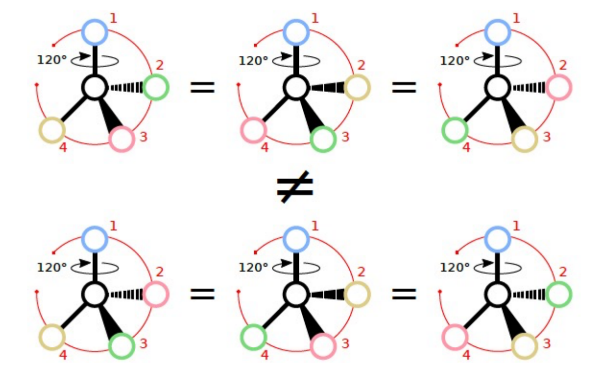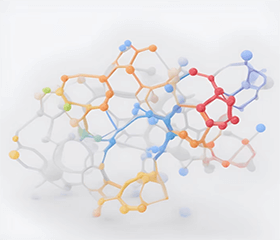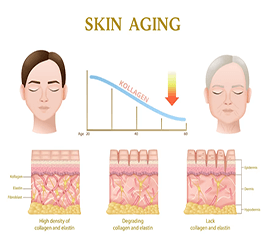Breast cancer happens when cells in your breast grow and divide in an uncontrolled way, creating a mass of tissue called a tumor. Like other cancers, breast cancer can invade and grow into the tissue surrounding your breast. It can also travel to other parts of your body and form new tumors, causing metastasis. The etiology of breast cancer may be among the most complicated of all cancers given inherent, life-long exposures to multiple endogenous and exogenous factors. The etiology of breast cancer is strongly influenced by defects in the DNA damage repair (DDR) components, in particular to defects of homologous recombination repair (HRR). In 2020, there were 2.3 million women diagnosed with breast cancer and 685,000 deaths globally. As of the end of 2020, there were 7.8 million women alive who were diagnosed with breast cancer in the past 5 years, making it the world’s most prevalent cancer. There are more lost disability-adjusted life years (DALYs) by women to breast cancer globally than any other type of cancer.
Women with breast cancer have many treatment options, including surgery, radiation therapy, hormone therapy, chemotherapy, immunotherapy, and targeted therapy. Treatment options for a woman diagnosed with breast cancer may include more than one type of treatment (ex. Surgery and radiation) or more than one agent (multi-agent chemotherapy). Among the risk factors for breast cancer, family history is the most important. Therefore, genetic factors are known as the major causes of breast cancer.
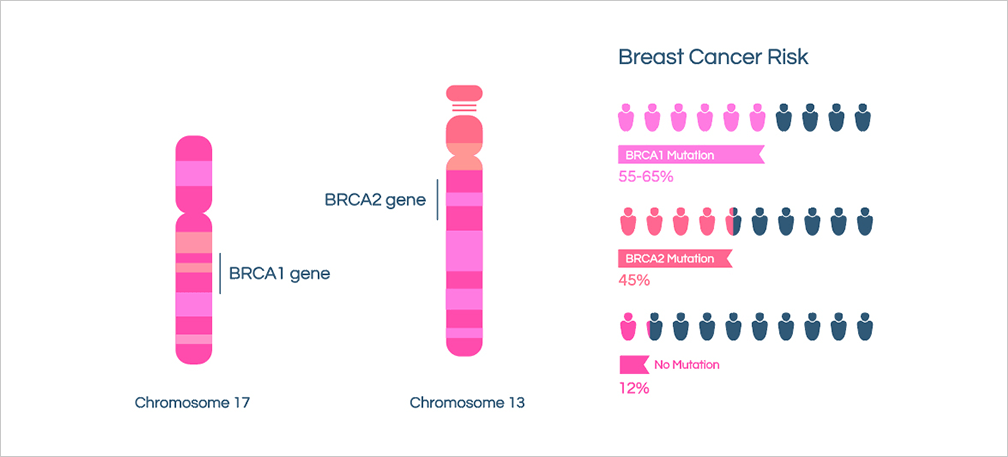
Germ-line mutations in BRCA1 and BRCA2 genes are the main part of genetic and hereditary factors for breast cancer. Mutations in these two genes are responsible for 90% of hereditary breast cancer cases. BRCA1 and BRCA2 genes produce Tumor Suppressor Gene (TSG) proteins. They are involved in the repair of chromosomal damage with an important role in the error-free repair of DNA double-strand breaks. When these genes are rendered inactive due to mutation, uncontrolled cell growth results, leading to breast cancer. BRCA genetic alterations known to increase individual cancer susceptibility are referred to as “deleterious” mutations and, in most cases, they introduce premature stop codons leading to truncated and nonfunctional proteins. Recent estimates suggest that 55 to 65% of BRCA1 mutation carriers, and approximately 45% of BRCA2 mutation carriers will develop breast cancer by age 70. A recent study of 21,401 families suspected of having a deleterious BRCA mutation showed that 24% of the families carried a pathogenic BRCA1 or BRCA2 mutation.
Targeted therapies called poly(ADP-ribose)polymerase ( PARP ) inhibitors have been approved for the treatment of some women with breast and ovarian cancers that have BRCA mutations. PARP inhibitors have been developed to hamper DNA repair by blocking PARP enzyme activity and PARylation reactions. Their mechanism of action requires competition with NAD+ for the interaction with the PARP catalytic domain. The close link between BRCA and PARP1 was highlighted in 2005 when two research groups independently discovered that PARP inhibition induces synthetic lethality in mutated BRCA1 or BRCA2 cancers.
New findings from a new phase III trial - OlympiA - show that olaparib added to standard treatment cuts the risk of women dying by 41 per cent – resulting in more women remaining cancer free and becoming breast cancer survivors. OlympiA is a prospective, multicenter, multinational, double-blind clinical trial with eligible patients randomly assigned to receive either olaparib or placebo for 1 year, after the completion of standard adjuvant or neoadjuvant chemotherapy and local therapy. OlympiA trial researchers studied 1,836 women with HER-2 negative breast cancer, who also had a mutation in their BRCA1 or BRCA2 genes and had undergone standard treatment, including surgery, chemotherapy, hormonal therapies, and radiotherapy, where appropriate. Patients were randomly allocated to receive either 300mg twice a day of olaparib or a placebo for one year and were then followed up.
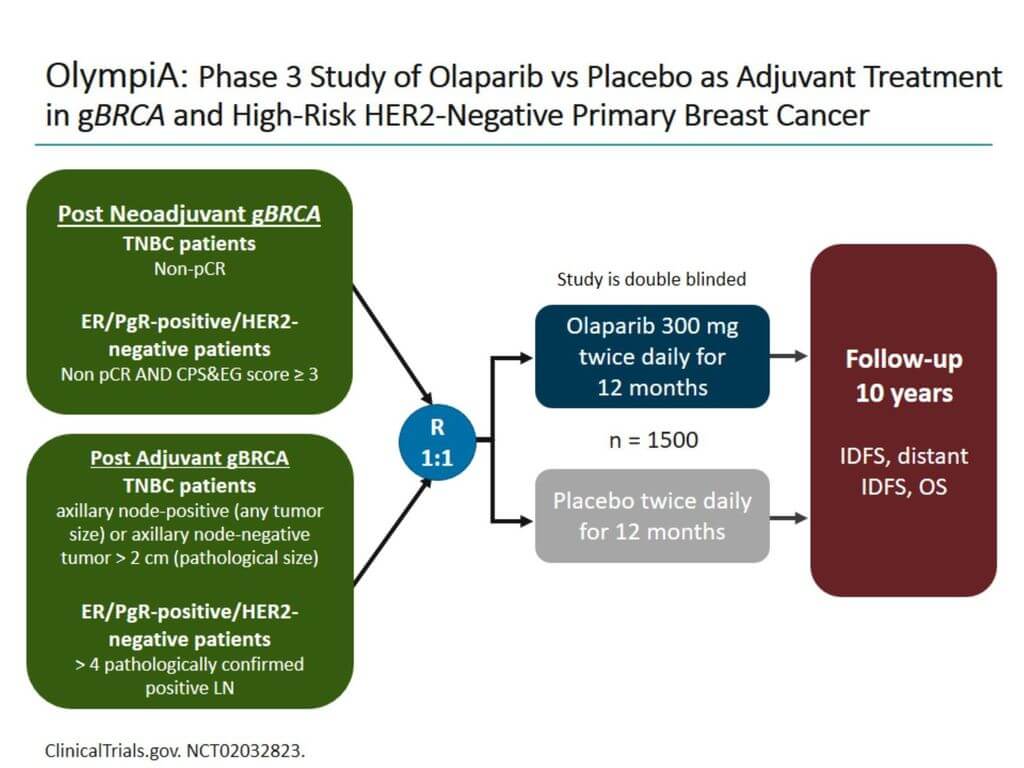
In the OlympiA trial, the researchers hypothesized that olaparib would provide benefit as an adjuvant therapy for patients with germline BRCA1 or BRCA2 pathogenic or likely pathogenic variant–associated early breast cancer who have a high risk of recurrence despite standard-of-care local and systemic therapy. The trial will follow participants for a total of 10 years but reported its first results after just two and a half years following a planned review by an independent monitoring committee which found that olaparib reduced the risk of breast cancer returning by 42 per cent.
A total of 1836 patients were enrolled in the study and randomized 1:1 to olaparib (n = 921) or placebo (n = 915). Patients were treated with olaparib 300 mg twice daily for 1 year or a matching placebo. Patients were stratified by hormone receptor-positive status, receipt of neoadjuvant or adjuvant chemotherapy, and whether they received prior platinum-based chemotherapy.
At baseline, patients in the olaparib arm had a median age of 42 years (range, 36-49) and 43 years (range, 36-50) in the placebo arm. More patients in both arms had germline BRCA1 than BRCA2 mutations. In the olaparib group, 18.2% of patients had estrogen receptor (ER)-positive, PgR-positive/HER2-negative disease and 81.5% had triple-negative breast cancer. In comparison, 17.2% of patients in the placebo arm had ER- and/pr PgR-positive/HER2-negative breast cancer and 82.8% had triple-negative breast cancer.

Considering the significance boundary was crossed in the study, researchers compared overall survival (OS) at 3 years to OS at 4 years, the rates were 3.8% versus 3.4%, respectively. In addition to the intention-to-treat (ITT) population, treatment with olaparib appeared to be favored across most subgroups. The exceptions were patients who received adjuvant chemotherapy, those who received prior platinum-based chemotherapy, and patients with HR-positive/HER2-negative disease.
At the second OS analysis, investigators also looked at longer follow-up data for iDFS and DFFS. Tutt explained that iDFS events remained lower in the olaparib arm at the second analysis with 134 events compared with 207 events in the placebo arm (stratified HR, 0.63; 95% CI, 0.50-0.78). The majority of the subgroups also had a more favorable iDFS result with olaparib versus placebo, excluding those who received platinum-based chemotherapy, patients with HR-positive/HER2-negative disease, and those with a germline BRCA2 mutation.
DDFS benefit with olaparib was also sustained at the second analysis. There were 107 DDFS events in the olaparib arm compared with 172 in the placebo arm (stratified HR, 0.61; 95% CI, 0.48-0.77). Similar to the other subgroups and the ITT populations, patients who had prior platinum-based chemotherapy, HR-positive/HER2-negative disease, and those with a germline BRCA2 mutation.
OlympiA steering committee chair Professor Andrew Tutt, Professor of Oncology at The Institute of Cancer Research, London, and King’s College London said: “Today’s results are great news for many women with inherited breast cancer. Most breast cancers are identified in the early stages and many patients will do very well, but for some, the risk of cancer returning remains unacceptably high, even after chemotherapy. OlympiA has shown that after selecting women with inherited BRCA mutations through genetic testing, we can use olaparib to directly target the weakness in their cancer and improve their survival. I hope to see BRCA1 and BRCA2 testing used for more women diagnosed with early-stage breast cancer, so that we can determine who can benefit from this personalized treatment approach. Olaparib provides a much needed new individualized and targeted treatment option to keep more women with inherited breast cancer free of disease and alive and well after their initial treatment.”
The study also found that the safety profile of olaparib was consistent with that previously reported. Serious adverse events were not more frequent with olaparib than with placebo. Although PARP inhibitors are DNA-interacting drugs and have the potential to induce mutation in DNA and hematologic malignant conditions, the frequency of myelodysplastic syndrome or acute myeloid leukemia was not increased by olaparib.
Results from OlympiA underscore the importance of genomic testing, Tutt explained, stating; “Germline BRCA1 and BRCA2 sequencing is an important companion diagnostic for adjuvant treatment decisions in breast cancer. Based on these data, olaparib has just been licensed by the FDA for the adjuvant treatment of adult patients with germline BRCA1/2 mutations and HER2-negative high-risk early breast cancer who have been treated with neoadjuvant or adjuvant chemotherapy.”
About PARP
PARP is a multi-function protein that plays roles in DNA repair, genomic stability, and programmed cell death. Eighteen members have been identified in the PARP family so far, among which PARP-1 is the most important member and plays dominant roles in DNA repair pathways. The key enzymatic activity of PARP is to add ADP-ribose to substrate protein via cleavage of NAD + and release of nicotinamide. This parylation activity is activated by DNA strand breaks, which leads to addition of Par to PARP1 itself and other DNA repair enzymes; thus, PARP is critical for the recruitment of DNA repair proteins to the damage sites.
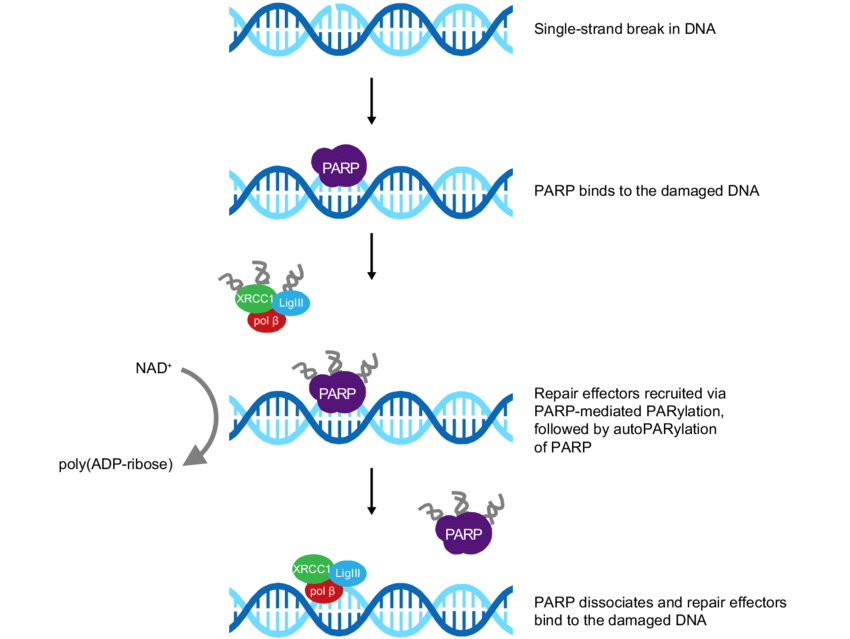
The mechanism of action of the PARP inhibitors have been attributed to leading to synthetic lethality in BRCA mutations. PARP inhibitors prevent the repair of single-stranded breaks (SSB), which are subsequently converted to double-stranded breaks (DSB). PARP inhibitors can also trap PARP at SSB and prevent its repair. Since cells lacking BRCA1 are deficient in HR, the accumulation of DSB eventually leads to cell death via apoptosis.
Recently, a growing body of evidence indicated that a broader population of patients could benefit from PARPi therapy far beyond those with germline BRCA1/2 mutated tumors. Numerous biomarkers including homologous recombination deficiency and high level of replication pressure also herald high sensitivity to PARPi treatment. Besides, a series of studies indicated that PARPi-involved combination therapy such as PARPi with additional chemotherapy therapy, immune checkpoint inhibitor, as well as targeted agent had a great advantage in overcoming PARPi resistance and enhancing PARPi efficacy.
References:
- Zheng, Feiyue, Yi Zhang, Shuang Chen, Xiang Weng, Yuefeng Rao, and Hongmei Fang. "Mechanism and current progress of Poly ADP-ribose polymerase (PARP) inhibitors in the treatment of ovarian cancer." Biomedicine & Pharmacotherapy 123 (2020): 109661.
- Yi, Ming, Bing Dong, Shuang Qin, Qian Chu, Kongming Wu, and Suxia Luo. "Advances and perspectives of PARP inhibitors." Experimental hematology & oncology 8, no. 1 (2019): 1-12.
- Caulfield, Sarah E., Christine C. Davis, and Kristina F. Byers. "Olaparib: a novel therapy for metastatic breast cancer in patients with a BRCA1/2 mutation." Journal of the advanced practitioner in oncology 10, no. 2 (2019): 167.



